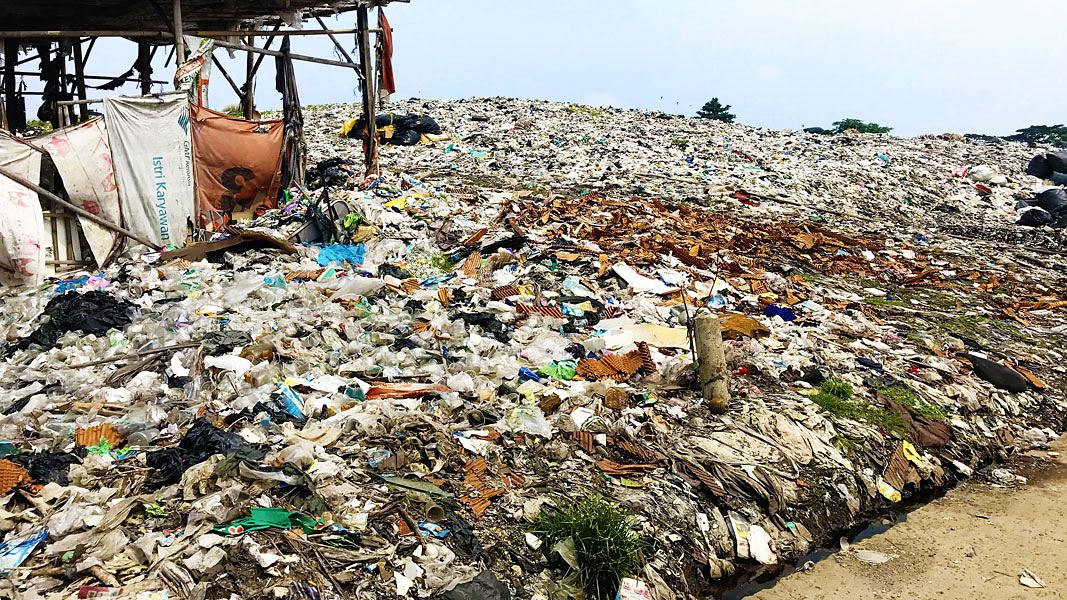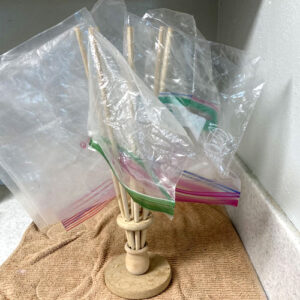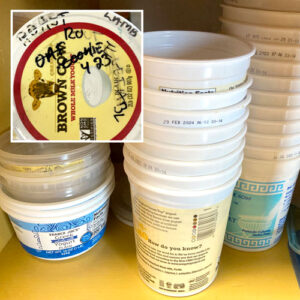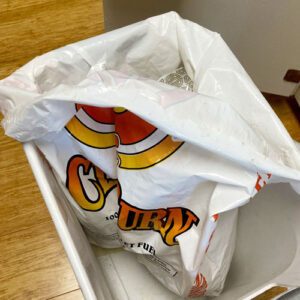Top: Plastic waste in Indonesia. Photo by Chuck Henry
 Sally Brown
Sally Brown
BioCycle is “The Organics Recycling Authority” and technically plastics, being carbon based, are organic. But thankfully, by and large, they are not our headache. Each year more than 380 million tons of plastic are produced. Since production ramped up in the 1950s, about 9.2 billion tons of plastic have been generated, a majority of which is now likely waste. One estimate has plastic waste generation at 34 million tons annually. Of that, 93% ends up in landfills or oceans (Ahsan et al., 2023). One optimistic estimate has recycling rates up to a whopping 9% (Rosenboom et al., 2022).
To put this into some perspective, about 20% of all plastic waste is generated in the U.S. (Garcia and Robertson, 2017). Our annual production of plastic waste totals 76 million tons. That comes to about 230 kg of plastic waste/person/year of which 23 kg (about 51 lbs), on a dry weight basis, are recycled. (You don’t think about wet weight when talking about plastic.) In comparison, the U.S. Department of Agriculture estimates that we waste 66.5 million tons of food each year. That is likely reported on a wet weight basis. Dry weight makes that 13.3 million tons per year or 39 kg (about 86 lbs) per person. Our headache, not to lessen its impact, is peanuts (and not the Styrofoam kind) in comparison.
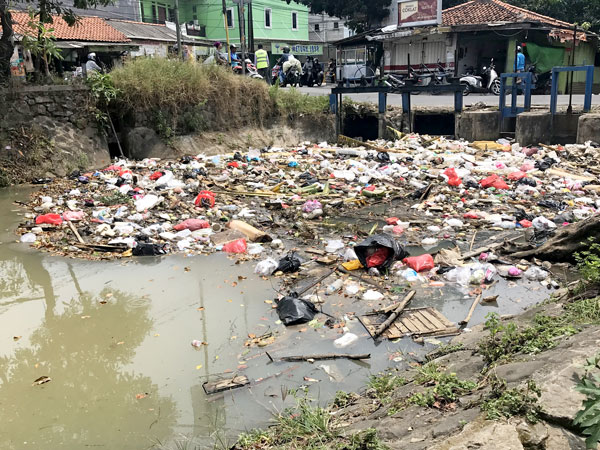
Globally, it is estimated that 34 million tons of plastic waste are generated annually — much of which ends up in oceans and waterways. Photo by Chuck Henry
Plastic Fundamentals
Plastic is complicated because that one word covers a huge umbrella. Each type of plastic has a unique chemical structure. Some are blends of multiple types or interwoven layers. Many have additives. All are derived from petroleum, the basic building block for plastic. Five to seven percent of all oil extracted goes to making plastic (Rosenboom et al., 2022). Increased availability of oil as the result of more aggressive extraction technologies and the move to electric vehicles will likely increase the importance of plastics as a revenue stream for oil producing countries and companies.
Good or bad, using plastic doesn’t release carbon dioxide (CO2) the same way that burning fossil fuel does. Plastic tends to stay as plastic. Their emissions are associated with getting the petroleum (61%) and making the polymers (30%). Only when some of that plastic is burned for end of life (EOL) management is the CO2 embedded in the material released into the atmosphere (about 9% of total plastic-associated emissions).
Plastic Recycling
Recycling plastics is nowhere near as straightforward as composting food scraps. With food scraps, the carbohydrates, sugars, and proteins in the materials all taste delicious to the microbes that do the digestion. The different types of plastics have different properties that make them special. They don’t mix well, putting them in the failing to not play well with others category. There are some options for recycling plastics as a general umbrella category.
My husband (big on this simple solution concept) told me about ByFushion, a start-up that makes construction blocks out of mixed plastics. Trex lumber is another example. Build your deck with recycled plastic film and reclaimed sawdust. These are great things and can help fill the demand for plastic used in construction (16% of total plastic recycled). The longevity of plastic is an asset when it comes to building a deck. But that leaves a big vacuum for packaging (35.9% of plastics), textiles (14.5%) and consumer goods (10.3%).
The optimal way to recycle plastics is to do so in a way that you can use the recycled stuff instead of new stuff. We do this with glass. Recycled glass bottles can turn right back into bottles made from recycled glass. Recycled paper can turn right back into paper. To recycle plastics to make similar products or high value products, they must be separated into their own individual groups. This is an attainable goal for certain types of plastic and much more of a challenge for others. The success of the process is partially dependent on what type of plastic and the method used to recycle it.
The most common approach to plastic recycling is to use force and heat, i.e., shred or grind and heat to make new products. This can work well for certain kinds of plastic, especially if it is well sorted and contaminant free. Good luck with that. The two types of plastic best suited to mechanical recycling are polyethylene terephtalate (PETE), labeled for recycling as #1, and high-density polyethylene (HDPE), labeled as #2 (Garcia and Robertson, 2017). These two types of plastic make up 9% and 37% respectively of total plastic produced. PETE is most commonly used for beverage containers. Recycled, it makes great fleece jackets. PETE recycling rates are very high in Norway (97%), Japan (83%) and India (90%), where deposit systems are in place or people get paid for bringing bottles to recycling plants.
Chemical recycling is more expensive and requires more capital to get up and depolymerizing. This process is based on taking the long chains of monomers — the repeating blocks that make up plastics — and breaking them apart, aka depolymerizing them. Once that is done you can start building your Legos back up again. Currently this type of recycling accounts for < 1% of all plastics recycled. It has the potential to grow in importance as processes are improved and subsequently, costs reduced (Rosenboom et al., 2022). One way to increase the quantity of plastic recycled is to design polymers with recycling in mind. There are advances in this field that may bear fruit. Examples include designing additives to existing polymers or altering how polymers are joined together to make separation of mixed plastics a realistic option (Garcia and Robertson, 2017).
Plastic Recycling Success?
Some places do better with plastics recycling than others. The U.S. is not a world leader in this regard. As of 2017, recycling rates of postconsumer plastics in Europe had increased by 64% (Raegert et al., 2017). In 2014, almost 30% was recycled. An additional 40% was used for energy recovery with only 31% landfilled.
Here, in my green hometown of Seattle the process is very confusing. I am an old fan of the numbering system, e.g., #1-PETE, #2-HDPE, #3-PVC (polyvinyl chloride), #4-LDPE (low density polyethylene), #5-PP (polypropylene), #6-PS (polystyrene). You look for the number on the bottom of the potentially recyclable plastic. That tells you whether to put it in the blue bin or the garbage, depending on where you live.
But no, in Seattle we have moved past the number system. States the Seattle Public Utilities website: “In Seattle, we ignore the numbers on the plastic containers. They denote the type of plastic resin the container is made of, not its ability to be recycled. In Seattle, you can recycle the following plastic items: rigid food containers such as bottles, cups, take-out containers, tubs, jars, lids wider than 3 inches; plant pots; and bags, if they are bundled and tied together.”
I think that Seattle is trying to make it easier and trying to do the right thing. I do my best to comply but likely end up putting unrecyclable plastics into the blue bin. I think of this as my own personal version of President Obama’s Audacity of Hope. For those with stronger feelings about plastic recycling and deeper pockets, Seattle households have an alternative: Ridwell, a relatively new company, promises it will do the right thing with your plastics. It offers recycling of multi-layer plastics such as food packaging as well as plastic films and clamshell containers via door-to-door collection. Ridwell also tells you where your plastics go with the end use being different types of construction materials.
My Own Plastic Odyssey
Trying to live a life without plastic is not really an option, although I’m sure you can find someone somewhere who has managed to do it. But that level of herculean effort is not practical on an everyday, humanly achievable kind of scale. Here are some of the things I do to try and reduce my plastic impact — many of which you also likely do.
- Stainless steel water bottle. These have gotten easier to use now that drinking fountains in many places double as water bottle refilling stations. I take extra pride in my water bottle because I got it from a lost and found. Even my stainless steel is secondhand.
- Grocery bags. It’s hard to go most places in this country and not see people equipped with reusable bags. Washington state pushed us to use them when it banned single-use grocery bags as a giveaway in supermarkets. The reusables make it easy to not miss those plastic grocery bags.
- Ziplocks. I tried silicon ziplocks to replace my plastic ones. They are very expensive and a pain to use, no matter which brand I’ve tried. So instead, we wash and reuse and wash and reuse. The best thing I’ve found was a gift — a wooden, multi-branched thing that is perfect to dry the plastic ziplocks on. While I haven’t given up my plastic ziplocks, I can now not only wash them but dry them relatively easily.
- Repurposed plastic containers: Tupperware has gotten a run for its money from repurposed plastic containers. The quart yogurt containers are my favorites. They are not see through but with a Sharpee pen, you can label them, taking away that mystery stuff in the freezer potential.
- Garbage bags. Dog food bags and the ones from the pellets from our stove make the best trash bags.
Even with my home reduce/reuse options — and hope-filled use of the blue bin — my garbage is filled with plastic. At this point you should be welcoming the much more simplistic recycling of moldy and smelly food scraps with open arms. The issue with that is, too often those come wrapped in plastic bags.
Part II of this Connections column takes a look at bioplastics and composting.
Sally Brown, BioCycle Senior Adviser, is a Research Professor at the University of Washington in the College of the Environment.


